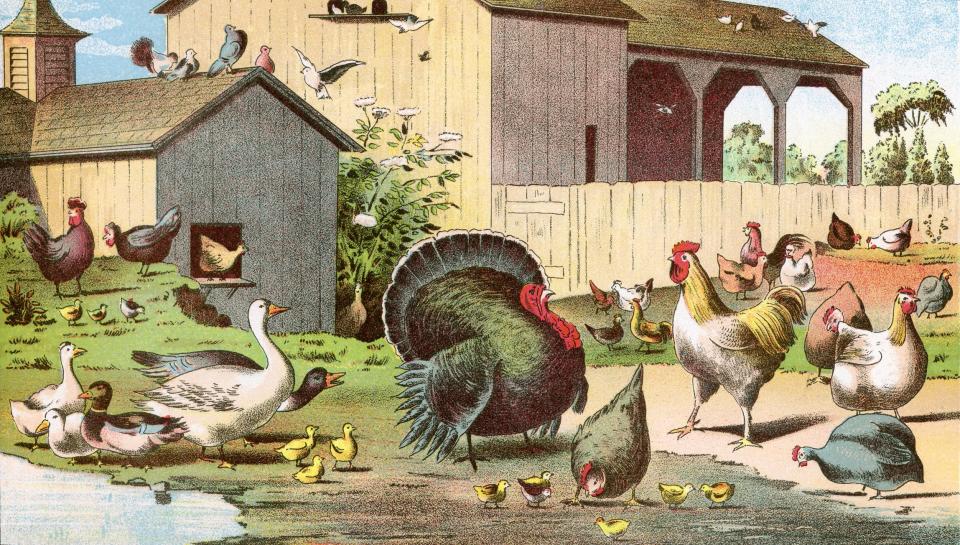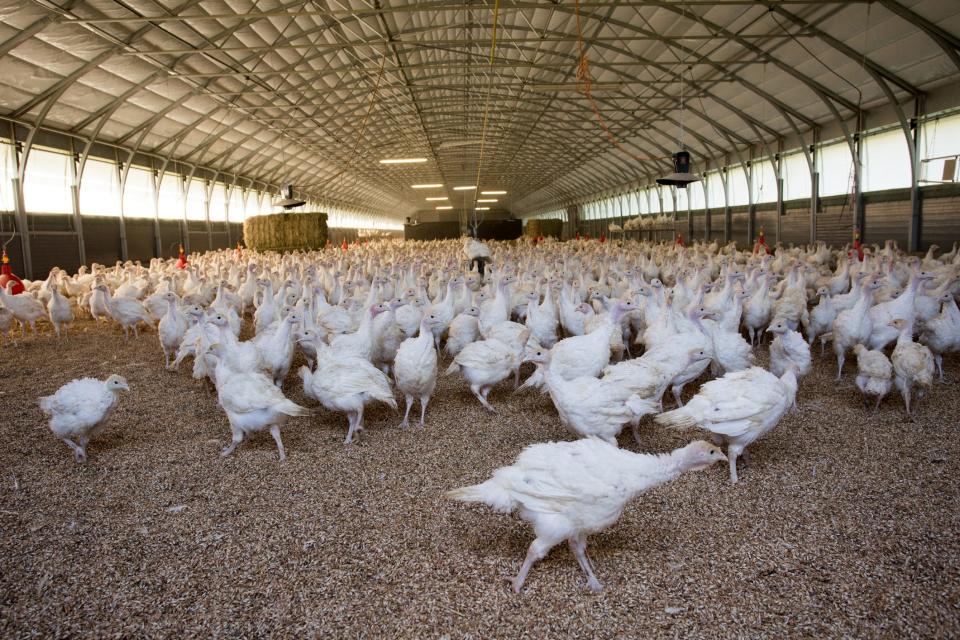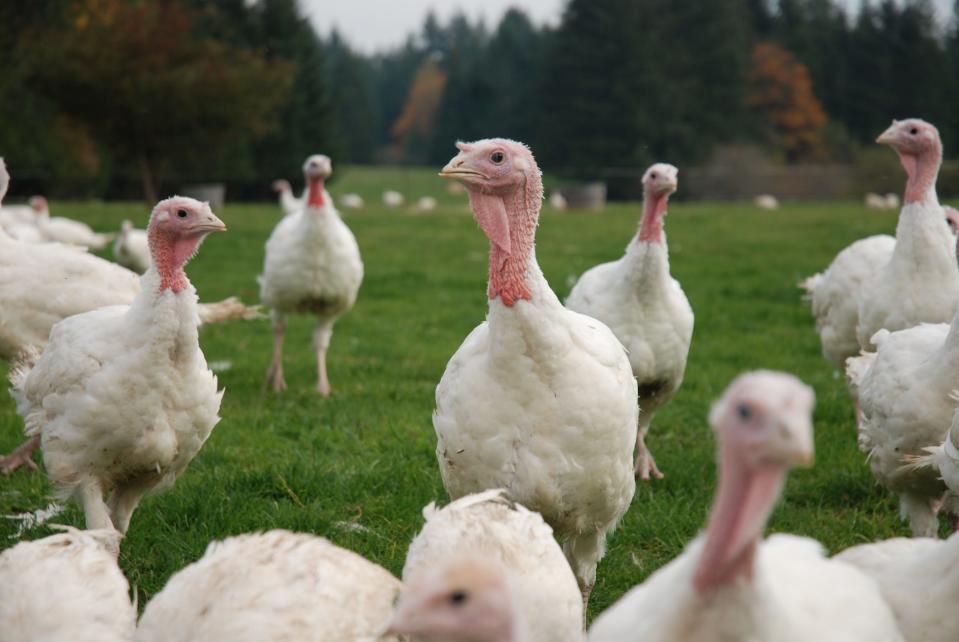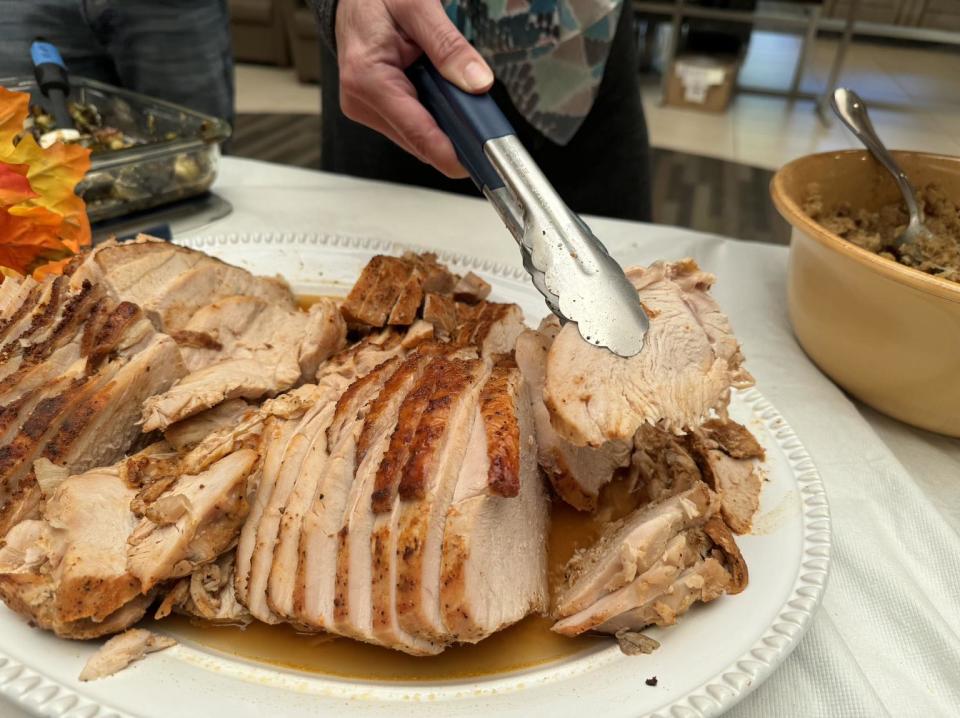Some turkeys are so big they have a hard time walking, but scientists have found ways to breed healthier birds

By the mid-20th century, some turkeys were growing so big, so fast their skeletons couldn't keep up.
Fast-growing turkeys may be less nutritious and lead to striped, pale, slimy meat.
Heritage turkeys that grow slowly and can reproduce naturally may be a more sustainable option.
Before the mass-breeding programs of the early 20th century, turkeys took roughly 28 weeks to get to their full size, growing at an estimated rate of about 0.75 to 1 pound per week, according to one study.
Some modern turkey breeds, such as the Broad-Breasted White, can grow nearly three times that fast, according to another estimate. That rapid growth isn't just a problem for the animals but for farmers and consumers, as well.
However, some scientists are on the hunt for healthier breeding methods that are better for birds and more sustainable for farmers.
How turkeys got so big

Much of a turkey's rapid growth is in its breast, where the white meat comes from. Since the 1930s, American farmers have been cross-breeding turkeys to get bigger and bigger breasts.
By the mid-20th century, research shows that farmers ramped up the speed at which turkeys grow, too. So turkeys were growing unnaturally large at an unnatural pace.
Some birds' skeletons and leg muscles couldn't expand nearly fast enough to compensate. That's why some modern turkeys have disproportionately massive chests with legs too small to fully support their weight, researchers report.
A recent study on growth rates of over 275,000 turkeys in Canada found over 70% had some level of mobility problems. The birds who grew the quickest were more likely to have weak muscles, a lop-sided gait, and poor balance.
But the data on all those turkeys came from a single large-scale breeder, Hendrix Genetics, which did not respond to Business Insider for comment. Other large-scale farms and smaller farms that raise their turkeys on pastures, with outdoor access, may see varying levels of mobility issues.
Business Insider spoke with John Vesecky of Vesecky Family Farms in Kansas, who raises both heritage breeds and Broad-Breasted Whites.
"The Broad-Breasted Whites grow faster than the heritage birds, and they grow bigger, but they can still move," Vesecky said.
Their aerial skills, however, could use some work. "The Broad-Breasted Whites are too heavy to fly," Vesecky said. "They can jump a few feet onto the feeders but not much more." Meanwhile, his heritage birds regularly fly up and roost on the tops of buildings.
Vesecky said pasture access makes a big difference in the birds' health, giving them space to walk around foraging for grasses and bugs. He also places their feed and water supply in different locations. This environment encourages the birds to move and strengthen their legs.
"They're raised like a bird ought to be raised," he said.
Why rapid growth is a problem for birds and farmers

Rapid growth does have its perks.
The sooner a bird reaches its full size, the less time and resources a poultry farmer has to spend raising it. Because the farming process is more efficient, modern turkey meat tends to be cheaper (albeit blander) than meat from heritage breeds, according to research from Penn State.
But there may be some trade-offs in terms of nutrition. A 2009 report funded by the United States Department of Agriculture found slow-growing heritage turkeys had more vitamin A content in their breast meat than fast-growing turkeys raised with the same environment and feed.
It is possible that the slow-growing turkeys were more active than the fast-growing ones and foraged on plants that contributed to vitamin A content, Anne Fanatico, the report's principal investigator and a professor of sustainable development at Appalachian State University, told Business Insider.
Researchers have found that modern turkey meat is also more likely to have defects. Fast-growing turkeys put on weight so quickly that their carcasses can develop stripes of fat where muscle should be.
This meat is also more likely to be "pale, soft, and exudative", aka slimy, another study found. Researchers report that differences in muscle structure are more likely to cause changes in acidity after slaughter, which can cause poultry meat to develop oozy secretions and a yellowish hue rather than a healthy pink.
Another study found that pale turkey meat taken from a slaughterhouse in Turkey had significantly less protein than regular meat.
Slimy turkey can also be a turnoff for hungry customers. According to a 2009 article, pale, soft, and exudative defects cost the US turkey industry over $200 million a year.
Moreover, in rare cases, birds with severe mobility issues may have trouble reaching feeders and drinkers on their own, according to research.
Put simply, turkeys who can't walk well would be unlikely to survive without human intervention. Even under the care of farmers, these turkeys tend to have shorter, less healthy lives, researchers report.
How to breed healthier birds

Thankfully, a healthier breeding stock of turkey may be on the horizon.
So long as a bird's growth rate stays under a certain threshold, researchers say mobility issues are less likely.
The trick is figuring out which birds are best to breed.
Aviagen, an international breeder of turkeys and chickens, uses advanced imaging technology like X-ray and computed tomography (CT) scans to image birds' skeletal structure and identify turkeys that can walk well but still grow at a rapid rate. The technology lets breeders spot potential leg defects before allowing a bird to mate.
Unhealthy birds are kept out of the breeding stock, regardless of how quickly they grow. This theoretically would help prevent mobility issues from passing on to the next generation. Aviagen didn't respond to Business Insider's request for comment on the success of this program so far.
Heritage turkeys are another option for consumers to consider. According to the Livestock Conservancy's criteria, heritage turkeys grow slowly enough that they stay mobile and can reproduce on their own.
"It is more sustainable to raise animals that can breed naturally," Fanatico said.
Fanatico added that consumer interest in heritage turkeys is growing, especially as local, community-based food systems become more common. Even though heritage turkeys take more time to raise, some people are finding that good meals come to those who wait.
Tips for buying the best turkey

Finding the perfect turkey for a holiday meal can be complicated. Here are some things to be mindful of when you shop.
First, make sure the meat is safe to eat. According to the US Department of Agriculture, the skin should be white or cream-colored, while the color of raw meat can range from pink to lavender blue.
Bruises in the meat are usually safe so long as the surrounding flesh hasn't been torn or punctured. You can cut the bruise off, and the rest of the turkey should be fine.
Spoiled turkey will smell foul and feel sticky to the touch. At that point, there's no "saving" the meat — you just have to throw it away, according to San Bernardino Environmental Health Services.
To avoid spoiled meat, be mindful of how long the turkey will be in your fridge or freezer. If you're shopping more than a few days ahead of time, the USDA recommends getting a frozen turkey.
If you want a turkey that's never been frozen, look for the word "fresh" on the label. In general, the USDA recommends waiting until one or two days before your meal to take a fresh bird home.
Moreover, turkeys labeled "fresh" or "minimally processed" aren't allowed to have additives like MSG or salt.
But farmers may have fed them antibiotics in order to prevent disease. To get a turkey raised without antibiotics, look for an organic label.
Any turkey you buy should be hormone-free by default, since the USDA doesn't permit farmers to give growth hormones to turkeys.
If you prefer the smaller, slow-growing breeds of turkey but want a larger bird, look on the label to find a tom (male turkey), as they tend to have more meat than hens.
But so long as you cook the meat properly, any size turkey should taste tender and delicious.
Read the original article on Business Insider

